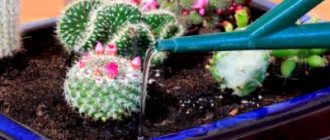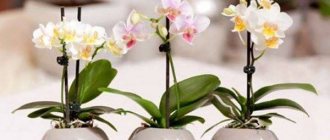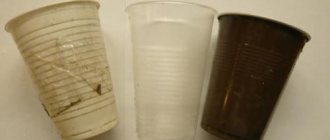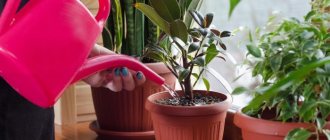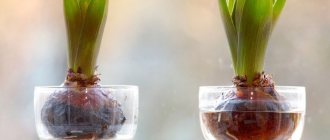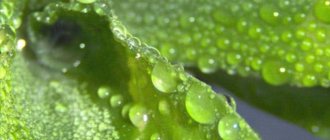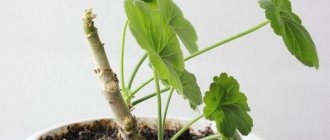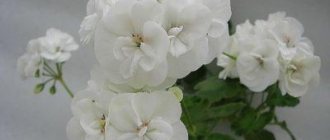Irrigation regime and rules
It is very important to know how to water geraniums correctly so that they look healthy and bloom profusely.
She loves moisture, but if water lingers around the roots and interferes with the access of fresh air, the roots may become sick and begin to rot. Therefore, the pot must have a good drainage layer and holes so that excess moisture is removed in a timely manner. For watering, it is very convenient to use a special container with a narrow neck; direct the stream of water along the walls of the pot so that it does not get on the leaves and branches.
In the spring, when the plant begins to actively develop, it is watered after the top layer of soil dries to a depth of 1 cm. You can check the humidity with your finger, a wooden stick, knocking on the pot or determining by weight. This usually happens within 2–3 days. As air temperatures rise and growth becomes more active, the need for humidification increases.
But you need to remember that it is best to maintain regular moderate watering, then the plant develops calmly and evenly. It is adversely affected by alternating drought and abundant watering. The more lush the plant and the higher the air temperature, the more often you have to water (it is advisable to first make sure that the top layer of soil is dry).
In summer this can happen every day. With the beginning of autumn, the frequency of watering is reduced and the soil is allowed to dry to a greater depth. When flowering has ended and active growth has stopped, it is advisable to water 2-3 days after the top layer of soil has dried out - that is, simply do not let the roots dry out. The appearance of indoor plants usually shows shortcomings in their care. So, the lack of sun leads to the fact that the geranium stretches out, all the branches are drawn towards it, and the lower leaves fall off. This may not be at all related to a lack or excess of moisture.
If pelargonium does not have enough moisture, its leaves will dry out at the edges. Excess moisture will lead to general lethargy, wilting and yellowing of the leaves. If the roots don't get enough air, they begin to rot - this is what happens when the ground around them is always too wet.
An urgent transplant into new soil will help save the plant. In this case, the roots need to be washed with a weak solution of potassium permanganate, all rotten parts should be cut off, the sections should be treated with charcoal or activated charcoal, and slightly dried. If the plant is overdried, then it can be placed in a tray with prepared water for a while - it will take the required amount of moisture on its own.
How to care?
Humidity
Geranium does not have any special requirements for humidity, but it loves fresh air. The culture tolerates humid and dry atmospheres.
Temperature
It is necessary to grow geraniums outdoors at an air temperature of at least 12 degrees. If this indicator decreases, the leaves will begin to fall off and droop.
Watering
It is necessary to moisten the plant regularly, but avoid standing water, as this can lead to the development of root rot.
But drought is also undesirable, otherwise the flower will not bloom or its inflorescences will become smaller and the leaves will begin to fade. But after watering, all elements of the plant will be restored. It is best to moisten the soil after the top layer has dried. Excessive soil irrigation causes the cessation of flowering.
Feeding
Geranium does not need abundant nutrition. It is quite enough to use compost and peat that were added to the hole before planting. An excess of fertilizers will have a detrimental effect on the formation of flowers.
Before flowering, you need to apply fertilizer containing phosphorus. Potassium compounds should be used once every 2 weeks during the formation of inflorescences and during active flowering, as they will provide large lush inflorescences.
Trimming
With the onset of autumn, you can move on to forming the geranium crown. Then it will be thicker and begin to bloom profusely. During pruning, it is necessary to leave the stem with 6-7 leaves.
If the bush has grown greatly for the winter, then at the end of February or at the beginning of March it can be pruned again. Cut shoots are perfect for cuttings.
Subsequently, to improve flowering and create a beautiful crown shape, cut off geranium shoots when 4-5 leaves appear. But only from December to January it is better not to touch the plant, as it enters a dormant period. There are many benefits to pruning geraniums:
- the bush turns out to be dense, as a result of which it acquires a compact and decorative appearance;
- pruning helps protect young leaves and shoots from diseases, since dried flowers and leaves are often affected by gray rot.
How to care for your garden in summer?
Summer care for geraniums grown outdoors is not very different from the standard. At this time, it is necessary to increase the amount of watering; the soil should not be allowed to dry out. Do not apply nitrogen-containing fertilizers anymore, as they promote the development of foliage, and flowering will be poor and unsightly. In the summer you need to add compounds rich in potassium, then the bush will bloom for a long time.
Diseases and pests of pelargonium
Gray rot. Symptoms: the lower leaves become covered with brown spots, which later spread throughout the plant. The leaves change color and dry out. Some areas of the flower are covered with a gray coating. Reasons: waterlogging of the soil, lack of ventilation, increase in nitrogen in the soil. Treatment: treat the flower with fungicidal agents.
Alternaria blight. Symptoms: petioles, leaf margins and leaf blades are covered with dark spots with a light center. The spots have a velvety formation. The leaves change color and dry out. There is no flowering. Causes: problem in the soil. She's infected. Treatment: proper care, treatment with fungicidal preparations.
Rhizoctonia rot. Symptoms: the appearance of dark spots on the stems, they are depressed in nature, the spots rise 25 cm along the stem. Leaves change color and wilt. The plant does not bloom. Cause: contaminated soil. Treatment: soil change, fungicide treatment.
Verticillium wilt. Symptoms: change in leaf color, blackening, wilting, no flowering. Reason: using the same primer for a long time. Treatment: get rid of remnants of vegetation in a timely manner, use clean substrates, and monitor soil moisture.
Rust. Symptoms: clearly shaped reddish spots appear on the plant. Causes: infection through water and air. Treatment: stop watering, trim leaves, treat with fungicidal agents.
Late blight of geranium. Symptoms: rapid decay, dry leaves, stops blooming, depressed spots on the roots. Causes: the infection is in the soil. Improper care, elevated temperature, excess fertilizer. Treatment: use the right soil, ventilate the soil, stop watering, treat with antibacterial drugs.
Rotting of stems and roots. Symptoms: flowering stops, fades, dies. Dark brown depressed formations appear on the neck and root. Later, suppuration of the affected areas begins. Reasons: contaminated soil, improper care, poor lighting, increased air temperature, increased nitrogen readings in the soil. Treatment: reduce watering, treat with fungicidal agents.
Leaf spotting and curling. Symptoms: does not bloom, spots on the leaf, grow over time, have a yellow color, sometimes the structure becomes oily. Causes: changes in leaf nutrition, the plant is affected, infectious insects can carry it. Treatment: treatment with fungicide. When propagating, use healthy plants.
Possible problems and illnesses
When growing geraniums, the following problems are possible:
- Geranium does not bloom. Most often, the lack of flowering in geraniums is the result of untimely molding of the crown. To prevent this from happening, the plant needs to be pruned regularly to encourage flowering.
There are also other reasons: low air temperature or lack of lighting, too fertile soil, too deep a planting hole, as a result of which the roots begin to actively grow, but it does not have the strength to flower, there are few nutritional components in the soil due to the lack of fertilizing.
- The leaves are turning yellow. This problem is very common, and the following reasons can affect it: if the leaves turn yellow and begin to dry at the edges, then the plant does not have enough moisture, if the leaves turn yellow and wither, then the reasons are excess moisture, yellowing of the lower leaves and their gradual falling off indicates about a lack of lighting, if the leaves turn yellow after transplantation, then this indicates the adaptation of the plant (read about geranium transplants here).
- Gray rot. It damages exclusively the leaf plate of the plant. It is necessary to immediately remove diseased leaves and stop watering. Finally, the geranium is treated with antifungal drugs.
- Root rot. It develops when the soil is frequently moistened, when the earth ball has not yet had time to dry out in the pot (read about the features of growing geraniums in a pot here). It will no longer be possible to save the plant; you need to get rid of it, and treat the soil in which the flower grew with a solution of potassium permanganate.
- Aphid. This pest can be green, gray or black. It is focused on the inside of the leaf plate. To get rid of the parasite, you need to use an insecticide, and the instructions will help you determine the dosage of the drug.
- Powdery mildew. This is a fungal disease in which the leaves and stems become covered with a white coating that resembles flour. The main reason for the development of the disease lies in high humidity. To defeat the disease, it is necessary to use a solution of copper sulfate and ammonium nitrate 0.5%.
Geranium is one of those plants that rarely get sick and suffer from pest attacks. The following problems occur extremely rarely:
You can grow geranium outdoors as an annual plant. There is nothing complicated about this, since this flower is not picky. It is important to provide it with adequate and regular watering, timely fertilizing and preventive measures against diseases and pests.
If you find an error, please select a piece of text and press Ctrl+Enter.
Since childhood, we have become accustomed to considering pelargonium (geranium) as a houseplant. However, from time immemorial it has been grown in flower beds. There are a huge number of garden varieties, and even many indoor varieties do well outside in the summer.
Therefore, today we will talk to you about planting geraniums in open ground, not only as an annual, but also about planting indoor specimens in the garden. Let's remember all the rules for caring for this beautiful plant outdoors.
Useful tips
If the climate allows, you can plant pelargonium in the garden in the spring. In this case, it is advisable not to remove it from the pot, but to dig it in directly with it. Otherwise, in the fall you will have to call an excavator to dig up the overgrown root system. Geranium tolerates direct sunlight on its leaves absolutely calmly. But at air temperatures above 35°C it is better to shade it a little. Still, this is excessively hot weather, burning the leaves and tops of the shoots. By the way, in winter it is enough to keep geraniums at +16-18°C. From spring to autumn it is advisable to stick to at least +21-22°C. The first sign that pelargonium does not like something is yellowing of the lower leaves. But what exactly does not suit the beauty, you will have to determine yourself
Overfeeding with fertilizers, excessive watering, incipient disease - any of these factors is reflected first of all on the color shade of the foliage. If you have any difficulties choosing a fertilizer for pelargonium, then pay attention to those products whose packaging is marked “for balcony plants.” It will be difficult to make a mistake here. From the age of 2 years, when transplanting, the size of the pot does not increase
By the way, a flower can grow for up to 10 years, or even more, if it is provided with suitable conditions. It is not recommended to pick off old dried leaves and wilted flower stalks with your hands, because there is a high probability of damaging the plant stem. It is better to do this with a sterile sharp knife. Seeds collected independently do not pass on the decorative qualities of parents to children. But don't despair. Maybe you can develop your own unique variety of geranium? There is an interesting observation: if a person likes the smell of geranium leaves, it means that something is wrong with his nervous system, and it would be advisable to check with the appropriate doctor. Those people who find the aroma unpleasant have a strong, healthy nervous system.
How to grow geranium at home? Completely simple and effortless. Do not treat pelargonium with disdain and it will thank you with clean air in the house and long, bright flowering.
Fertilizer and feeding of geraniums
It is most convenient to feed pelargonium with complex fertilizers for flowering plants from late spring to early autumn. In the spring, add more nitrogen so that the flower actively grows and recovers after pruning. Phosphorus strengthens the root system, and potassium promotes the formation of buds. At home it is easier to use special sticks, granules or watering solutions.
Photo: domashniecvety.ru
Optimal time for the procedure
The time it takes to adapt to a new location largely depends on the time at which the flower is transplanted. Typically, transplanting geraniums at home is carried out in the spring. With increasing daylight hours, the plant begins vegetative processes, and it most easily perceives stressful changes. At the same time, some gardeners are guided by the lunar calendar, knowing about the reaction of plants to the movement of the night star.
The winter months are considered the most unfavorable time. Transshipment of the plant, carried out in March or April, will give the best results and be the most painless.
Note! Transplanting pelargonium into the garden, be it a royal, zonal or ivy-leaved plant variety, should occur at the end of spring, that is, in the second half of May
You should move the flower back to your house or apartment before the onset of cold weather.
Is it possible to replant geraniums during flowering or in summer?
Geranium can be replanted at any time of the year, but under favorable conditions the plant blooms almost continuously throughout the summer. Is it possible to replant flowering geraniums?
During active budding, the bush spends a lot of resources and entails a protracted recovery period. As a result, the bush may not cope with stress and drop flowers. It is for this reason that it is recommended to postpone the transplant to another time.
Is a transplant necessary after purchase?
Many purchased flowers quickly die when they find themselves in a home environment. At the same time, the plant is provided with complete rest so that it can adapt to the changed external conditions, because in a short period of time the flower has gone through a number of stressful situations: replanting in the garden area, transportation, keeping in the store.
Experienced gardeners try not to replant geraniums immediately after purchase. In the first days after the appearance of a new plant, the apartment is maintained at optimal temperature and humidity.
What problems might arise?
Sometimes even the most undemanding plant has troubles. Let's look at the most common problems with geraniums:
- The leaves look like a rag, hang, and fall off when touched. These are the consequences of excess moisture. If you have had a rainy summer, thinning your plants can help. Otherwise, you may lose all landings.
- The leaves are drying. Not enough water. Perhaps you only water the top layer and the lower roots do not receive a drop of moisture. Mulching will help. The water will not roll off and evaporate.
- If gray mold appears on the leaves, you should stop watering completely.
- Whiteflies or aphids can settle on geraniums. These pests can be destroyed manually or treated with insecticides, otherwise they will suck all the juices out of the plant.
- If pelargonium does not bloom, and this often happens with the most beautiful varieties, if all conditions are not provided. See if the flower has enough light? Have you fed the plant?
How to replant geraniums - step-by-step instructions
Knowing what kind of land is needed for geraniums, they begin to transship the plant. It’s better to find out in advance how to transplant geraniums at home step by step and prepare everything you need.
In addition to moving an indoor flower from one pot to another, it is often transplanted into open ground in the spring and transferred back with the onset of autumn.
At home from one pot to another
Handling homemade geraniums is easy. The procedure consists of the following steps:
- Drainage is placed at the bottom of the container.
- A little earth is poured over the drainage layer.
- The flower is carefully removed from the previous pot along with the root ball.
- The plant is placed in a new pot, filling the voids with soil mixture.
After the transplant is completed, the flower is returned to the same place. The first watering is carried out no earlier than after 3-4 days.
In open ground
When geraniums are correctly moved into open ground, the perennial decorates the area with abundant flowering. To make the plant feel comfortable in the garden:
The soil in a selected well-lit area is dug up with the addition of a compost mixture. Prepare a small planting hole with a depth equal to the height of the pot containing the flower. The plant is carefully transferred to a new place and the soil around it is compacted with your hands. The transplanted geranium is watered abundantly with settled water.
Additional Information! When planting cuttings in the ground, they are buried 2-3 cm. The distance between them should be at least 25 cm.
From open ground to pot in autumn
For wintering, geraniums are returned to room conditions. You should figure out how to plant geraniums in a pot in this case.
Inspecting the roots helps prevent pests from being brought into your home.
After a thorough inspection:
The ground around the bush is watered. Prepare a pot with drainage and a small layer of soil. The flower is removed from the soil along with the root ball. The soil is carefully removed from the roots and inspected. At the same time, heavily overgrown, non-viable ends are cut off. The geranium is moved into a pot, sprinkled with soil and carefully compacted. A flower that spent the summer outside is transferred to a well-lit place with minimal shading
It is also advisable to trim the shoots to a length of 20 cm to help the geranium get used to the new environment.
A flower that spent the summer outside is transferred to a well-lit place with minimal shading. It is also advisable to trim the shoots to a length of 20 cm to help the geranium get used to the new environment.
How to prune geraniums
Pruning is the most important stage in caring for indoor geraniums, otherwise they will stretch out, become deformed and lose their decorative properties. And in the future it will get even worse. The crown needs to begin to form when the plant is still very young.
Each shoot has dormant buds, but they will not germinate while the stem is stretching upward. Therefore, they are encouraged by annual pruning in early spring. Shorten long shoots just above the leaf node, remove all shoots that grow inward, sprinkle the cuts with charcoal and feed the flower a little with nitrogen.
Small varieties are pruned less often - once every few years, and very little. Feel free to thin out the tall ones and shorten them by 2/3 - they will grow again. Geraniums of medium height can be trimmed by 1/4-1/3.
Strongly growing bushes should also be pruned in the fall so that the load in winter is less. The procedure is carried out according to the same principle, but only after the geranium has completely faded. Do not water the pot 2-3 days before and after.
Photo: mkdou19.ru
General rules for applying fertilizers
At home, when applying fertilizer for begonias, you should consider some factors:
- Light and temperature. The fastest absorption of fertilizing will occur only if the plant is in good health. Begonia loves light and warmth, and is afraid of sudden temperature changes and drafts.
- Time. It is better to use fertilizers in the evening or even at night, after dark.
- Water. The absorption of essential nutrients by the plant depends on soil moisture. It is better to water the flower a few hours before using the fertilizer.
- Safety. Fertilizers should not directly touch the plant. This may cause a chemical burn.
- Moderation. The quantity and frequency of fertilizer application must be observed. Excesses are just as detrimental to the plant as lack of substances.
Feeding begonias for abundant flowering and growth is done using both factory and folk remedies.
House begonias
If you did something wrong
Fertilizers must be applied carefully. If done incorrectly, the plant will immediately show a reaction. The main goal pursued by flower growers when using fertilizers is to increase the quantity and quality of buds and increase the duration of flowering.
For pelargonium to bloom, moderate application of nutrients is not enough . The timeliness of their application plays an important role in bud formation.
Problems and solutions
- The lack of buds may be caused by plant overgrowth and not by lack of nutrition. This fact is taken into account when deciding on feeding. It is enough to transplant the plant into a larger pot and rejuvenate the plant by removing old shoots. The frequency of transplantation is once every 2-3 years.
- Pelargonium damage by pests and disease infection leads to a lack of flowering. Before feeding, the plant is treated to remove the cause of the disease.
- Excess fertilizer will lead to rotting of the root system and an increase in green mass. The plant must be removed from the pot, all rotten roots removed and replanted in new soil.
- If there is insufficient feeding, the leaves will lose their brightness and elasticity. It is enough to carry out vitamin watering.
- A large pot will result in a lack of buds. Replanting into a smaller pot will solve the problem.
- Drafts and temperature changes harm the flower. By eliminating these negative factors, the plant will bloom in a month.
Timely and correct feeding is the key to blooming pelargonium. The independent growth of a flower without human intervention will not lead to abundant flowering. When feeding pelargonium, it is important to use an integrated approach. At home, choosing fertilizers is not difficult. Every housewife has yeast, iodine, milk, hydrogen peroxide and ash.
Caring for pelargonium in winter at home
For spring planting in flower beds, geraniums are pruned in the fall and sent to darkened and cool rooms. Glazed loggias and balconies are suitable. You should not send it to the basement or cellar for storage. They are more suitable for begonia tubers, rose cuttings, grape stems, and seedlings.
More often, geraniums are planted in new pots in the fall, the crown is given the correct appearance, and left in the apartment. Home conditions are suitable for keeping all year round. The flower does not need rest. Even in winter, pelargonium can delight with abundant flowering and decorate the windowsill with lush greenery.
Do you prune geraniums in winter?
Not really
Caring for geraniums at home in autumn and winter involves reducing watering to once every 7-10 days. Keep the plant in a cool place with a temperature of +15-18 degrees. Closer to spring, mineral fertilizing is carried out.
Watering and fertilizing
In winter, the number of waterings is reduced to one every 7-10 days. In hot conditions can be increased to 2 times a week
It is important not to let the soil dry out. Otherwise, the geranium turns yellow and drops its leaves
What water is suitable for irrigation:
- settled;
- melting;
- spring;
- rain settled.
What not to water:
- from the tap;
- with bleach;
- mineral.
During the rest period, fertilizing is not needed. According to the rules, to maintain winter flowering, once every 45-50 days is enough. Ready-made mineral fertilizers are suitable for home potted plants. Closer to spring, we recommend feeding with a solution of boric acid. It will increase the number of inflorescences by at least 1.5-2 times.
Instructions for preparing fertilizer at home:
- Buy boric acid powder.
- Mix 0.5 g of boric acid and 100 ml, leave for a minute, dissolve.
- Pour in 900 ml of cool water. Stir.
- Pour into a spray bottle.
The foliar feeding method is carried out in the evening. Do not expose the treated plant to sunburn. Spray the foliage and stems, the composition completely penetrates overnight.
Rules for caring for geraniums in winter
Temperature and lighting
This is a sun-loving plant. It is advisable to place pots on southern windows. With 10-12 hours of daylight, geranium will delight with flowering even in winter. If you move it to a fairly dark place, put it in the northern part of the house, the stems begin to stretch. Instead of a lush bush, a panicle of long, half-naked sticks grows.
The optimal temperature in winter is +15-18 degrees. This is below standard home conditions. It is usually cooler on the windowsills than in the room. Therefore, special cooling and ventilation are not required. The flower is not afraid of short-term drafts; you can periodically open the window and arrange ventilation.
You can keep geraniums in winter on an insulated loggia or balcony where there is enough sunlight. An important point is that the temperature should not fall below +10 degrees.
Trimming
In the cold season, the indoor plant loses its decorative appearance. In case of insufficient lighting, individual stems without side shoots are knocked out. The sticks stick out and spoil the picture. Initially, it is recommended to completely trim the poor bush to a height of 10-12 cm from the root. After a while, shoots will appear from the lateral buds.
A gentle way to maintain the attractiveness of geraniums in winter at home is to trim individual elements. In winter, the elongated branches are directly removed and the bush is given a rounded shape. In spring, umbrellas rise above the crown, surrounding the greenery with lush color.
Geranium (Pelargonium). Growing and care at home and outdoors
Geranium. Growing geraniums at home and outdoors. Geranium care
Indoor geranium or pelargonium is a very common indoor plant. Pelargonium or Indoor geranium can be found not only in many homes , but also on window sills in various organizations and even in flower beds .
To begin with, we note that essentially geranium and pelargonium are different plants. Pelargonium is a purely indoor, heat-loving plant, and geranium feels great both outdoors and at home. This is explained by the fact that one comes from warm countries, and the other from the northern regions. But it just so happened that pelargonium has long been called geranium , which is why we call it indoor geranium . Both plants have externally similar similarities, but if you cross them, then, alas, nothing will work.
Pelargonium combines not only beauty, but also benefits. This beauty on your windowsill will not only delight you with magnificent flowers, but will also help you purify the air and more. Pelargonium has already become a given and has become a part of our lives; such indoor geraniums stood on the windowsills of our great-grandmothers. In many after and before war films you can see it on the windowsills of houses.
Trending Pilaf with chicken and shrimp
In our article you will learn how to grow and care for this beauty correctly so that it pleases you with its healthy appearance and flowers all year round. Having familiarized yourself with the simple rules of care, you can easily grow simply luxurious indoor geranium (pelargonium) on your windowsill.
A little history of Pelargonium (indoor geranium)
The homeland of pelargonium is South Africa and India, where it has been growing for many centuries in the wild as an outdoor plant, but over time it has been cultivated and turned into an indoor plant form.
Geranium came to Europe at the beginning of the 16th century thanks to sailors who began to land on the shores of South African countries. There, the sailors noticed an unusual and beautiful flower and initially brought it to England, which is why there is an opinion that England is the birthplace of geranium, but this is not at all the case, it was brought there. The European nobility decorated it not only with their window sills, but even with their toilets, dresses and hairstyles, considering this to be the height of their wealth.
Indoor geranium came to our region at the end of the 18th and beginning of the 19th centuries; it was brought to us from England. Initially, it was a very expensive plant that only rich people could afford; only the nobility could decorate their home with it. But the years passed, revolutions occurred, and when the houses of the rich were robbed, some took out whatever they could, some took out furniture and valuables, and some took out pots of flowers. So the geranium began to grow among the people, housewives exchanged sprouts, and then new varieties began to come to us. But the British were the first to start growing new varieties.
Pelargonium (indoor geranium) - description of the species
Geranium is a perennial plant, growing mainly in the form of a bush, but there are varieties more similar to grass. Geranium leaves are always dissected and may resemble duck feet or blades.
Geranium blooms profusely, almost without stopping its flowering. Flowers are collected in inflorescences with at least 5 flowers, always on a long petiole. The color of the inflorescences is very diverse; it comes in almost all colors depending on its variety.
Its root is branched, but there are varieties with a root that resembles a rod. Geranium is not particularly whimsical, one might even say it is very easy to care for. She loves well-lit places, she does not like the shadow. Flowers and leaves have a pronounced specific aroma. An adult plant reaches a height of 70 cm, depending on the variety.
Propagation of indoor geranium (pelargonium)
Geranium propagates very easily; it can be propagated using seeds and petioles.
Reproduction using seeds is not a popular method, but it has a right to exist. In order to grow geranium from seed, after it has flowered, simply collect its seeds. Next, take a container for sowing seeds, pour soil or a special substrate into it, sprinkle the seeds on it and sprinkle it with a little soil, you should not deepen them too much, otherwise they will not sprout well, pour water at room temperature. Now cover the container with any transparent film that you have in your home, you can even use a regular grocery bag, the main thing is that it is transparent and transmits light well, you can cover it with glass, but watch the temperature, glass heats up the air in the container very much, it will need to be raised periodically to reduce the temperature. Place the container on a sunny window sill. When sprouts appear, remove the film and let them continue to grow without it. It is better to plant in separate pots when the sprouts are at least 5 cm tall. If you decide to plant seeds, you should know that this method does not guarantee that the plant will be the same as the one from which you collected the seeds; it may change.
Growing geraniums with petioles is a more popular and simpler method, just cut a small twig from an adult plant, it is better to do this when you already need to trim it a little, then put the petiole in water, the container should be transparent so the roots will grow faster, wait until it takes root . When the petiole has taken root and reached a length of 1-2 cm, it can be planted for further cultivation.
Planting indoor geraniums (pelargoniums)
Geraniums are planted in flowerpots, indoor pots and even in a flower bed. To grow indoors, take a medium-sized pot, it doesn’t need a large pot, a maximum volume of 2 liters is enough, or less is possible. She doesn't like big pots.
For planting, take a substrate for geraniums or even the most ordinary soil, which is even better suited for geraniums, from your garden or vegetable garden, it doesn’t matter at all. Our grandmothers certainly did not have a substrate, and they successfully grew geraniums for many years, the main thing is that if you take ordinary soil, check if there are earthworms there, they can spoil the root.
Next, pour about a quarter of the soil into the pot, now lower the cutting into the pot, so that from the root you cover the trunk 1 cm with soil, hold the shoot and fill it with soil until the pot is completely filled with soil. Water the plant with cold water, preferably at room temperature.
Caring for indoor geraniums (pelargonium)
Caring for geranium is not difficult; it is not a fastidious plant and does not require special attention. Just remember a few rules and your geranium will be lush, beautiful and will bloom constantly.
Rules for caring for geraniums:
The first rule of care is that geranium loves light, provide your beauty with a bright place, preferably on the sunny side of your house. If all your windows do not face the sunny side, then choose the brightest place in your house, preferably so that nothing shades the geranium itself.
Interesting on the topic:
I’m talking about planting dill and caring for it - just about...
Mar 5, 2022
Don't have a plot of land? 60 plants you can grow...
Mar 5, 2022
The second rule of care is that geranium is heat-loving, do not place it in the coldest room, choose a warm place for it, and in winter, when the windows are very cold, move it to a table next to the windowsill, so it will have enough light and warmth.
But there is also no need to overheat the geranium and placing it close to the radiator is not recommended, it is not a kitten that needs to be warmed up, it is still a plant.
The third rule of care is that geraniums do not like too frequent watering; they need to be watered rarely, as they dry out, but at the same time, this one-time watering should be plentiful, but not too much - do not create a mud bath in the pot.
The fourth rule of care is that when the peduncle has already faded, it must be cut off; this gives impetus to the formation of a new peduncle. It is necessary to cut as close as possible to the base of the peduncle and with something very sharp.
The fifth rule of care is that if you notice drying leaves, immediately remove them to the base of the leaf, before the dryness goes into the trunk of the plant and breaks it.
The sixth rule of care - geraniums sometimes need pruning, if you want a lush and beautiful bush, cut off the top and pinch the side branches, pruning is always done with a sharp object, you need to make a cut and not crush the branch.
The seventh rule of care is to turn the pot regularly, for example, once a week, so the crown will form correctly and evenly. If you don’t do this, it will stretch one side towards the light and the bush will turn out crooked; on one side it will always be larger, so turning it is necessary from the very beginning, as soon as you plant the sprout.
The eighth rule of care - do not spray geraniums, they do not need it. She doesn't like excess moisture at all.
The ninth rule of care is that for regular flowering, you can sometimes fertilize the geranium with iodized water, which it loves very much.
To do this, take 1 liter of water and drop only 1 drop of iodine into it. For one pot of geranium you only need 50 g of this solution; no more is needed, regardless of the size of the pot. But do not pour the solution onto the root; you need to pour it along the edges of the pot so that the solution flows into the ground along its walls. But don’t get carried away with this type of feeding - maximum once a month. There is no need to pour more than 1 drop of iodine into the water in order to fertilize it better, otherwise you will harm the plant and burn the roots.
What problems may arise when growing pelargonium?
Usually, indoor geraniums rarely cause problems when grown, but they may well arise. Let's look at them and find out what the reasons may be.
If you notice that the lower leaves of your geranium have turned yellow and have begun to fall off , then it is possible: It may not have enough light, perhaps a lot of shadow. Improper watering can also cause this problem; there may not be enough moisture, or the soil may often become too dry.
If, on the contrary the leaves begin to rot , it means you are flooding it and reducing the amount of moisture. In such cases, you just need to change the lighting and adjust the watering, and your problem will be solved.
If you notice redness on the edges of the leaves , your geranium is simply frozen. Move it to a warmer place, such as the kitchen, and this problem will go away. In cases where the leaves naturally have a reddish edge, the signal may be a change in tone to a darker one, for example, if it becomes dark or burgundy.
If pelargonium does not bloom , perhaps the conditions under which it is kept are not what it needs, perhaps there is not enough light and heat, or you are not watering it correctly. Adjust the growing conditions, and your geranium will certainly please you.
Remember that the cause of absolutely any disease of geranium is exclusively improper care for it. If you notice affected leaves or flower stalks that have rot, spots or plaque:
Remove them immediately! Adjust your watering! Adjust the temperature and lighting! Change the soil! And all problems will be solved!
Transplanting indoor geraniums (pelargoniums)
There is no need to replant geraniums often ; they generally don’t particularly like to be disturbed. For geraniums, replanting is stressful, which is difficult for it to endure and after replanting it may not bloom for a couple of months. Geraniums should only be replanted when they simply don’t have enough space, and it’s very easy to understand that they’re cramped. If you notice that its roots are just crawling out from the holes at the bottom of the pot, then it’s time to replant. Check the bottom of the pot once every six months, and if you see roots at the bottom, then there is still enough space for it and there is no need to disturb the beauty.
Fertilizing indoor geraniums (pelargoniums)
There is often no need to fertilize geranium ; it does not need constant feeding; this amazing beauty loves meager lands more. You can add a little humus to the top of the pot and fluff up the soil. Or purchase in a specialized store a special fertilizer that is intended specifically for geraniums. You can also fertilize geraniums with magnesium sulfate; this is an excellent fertilizer for geraniums, which stimulates the growth and flowering of the plant; this fertilizer is sold in any specialized store.
Growing indoor geraniums (pelargoniums) outdoors
You can also grow geraniums in a flower bed. To do this, you can sprout the petioles in advance or plant your geraniums out of pots outside, but geraniums from a pot may not bloom for a long time; when you transplant them into a pot in the fall, they will also begin to hurt and stop blooming.
Therefore, it is best to plant new petioles outside, which will grow well there. Outdoors you must follow all the same rules as when growing indoors. It is best to fertilize street geraniums with cow manure, which has already turned into humus; this is an ideal fertilizer for geraniums that grow on the street.
When growing outdoors, the soil under geraniums must be periodically flushed, because watering there is different from indoors, and the soil compacts faster. In the fall, the plants can be transplanted into pots and moved into the house, but it is better not to change the soil and fill the pots with the same soil in which they grew outside, so they will hurt less in the transplant field.
Wherever you grow your indoor geranium - indoors or outdoors, it will certainly delight you with magnificent flowers, you just need to help it a little by following the simple rules for caring for geraniums that we have discussed.
Also on our website you can find articles describing varieties of geranium and learn about all the benefits it can bring to you and your loved ones.
How to save dying plants?
Pelargonium is destroyed by both excess and lack of water. If you carefully monitor your pet, such extreme situations will not happen: she herself will warn her owners about discomfort. When a flower is thirsty, its leaves begin to dry out at the edges. If the bush has become lethargic, the leaves have lost their elasticity and turned yellow - the roots are overly flooded with water and begin to rot.
Overfilling often occurs when owners are away for several days or weeks. They read tips on how to create “automatic watering” using a high bucket and threads drawn from water into pots. Someone did not make a humidification system on their own, but bought a special device at a hardware store. All these techniques are not bad, but they need to be adjusted. If you use a cord that is too thick, the water will begin to flow out very quickly and will flood not only the flowers, but also the neighbors below. A few days before departure, check the system, make sure it humidifies, but does not flood the flowers, and you can go anywhere for at least a month.
It is not difficult to save a dried flower at home. Place the pot in a deep tray or bowl of water. Wait until the soil has collected the required amount of moisture, and then remove it from the water and allow the excess liquid to drain.
If you overwatered pelargonium, remove it from the soil and wash the roots with a light pink solution of potassium permanganate. Cut off all rotten shoots and sprinkle the wounds with crushed coal. Plant the flower in new soil and water it moderately in the future.
When we look at catalogs of flower collections, our eyes widen at the sight of exotic plants of unprecedented beauty; we want to take all kinds home. Often, expensive purchases end in disappointment: an inexperienced gardener has pitiful twigs without a hint of buds on his window instead of a lush bush. It is better not to immediately take on capricious, demanding plants. Start with a simple task: place an unpretentious geranium on the window and learn to care for it so that it blooms profusely and the bush covered with huge colorful caps makes all the neighbors envy. Go from simple to more complex, and after a while you will learn to understand the needs and wishes of each of your green pets.
Can it grow outside?
Geranium has long been grown in flower beds under the following conditions:
- Well-lit area for planting.
- The soil should be fairly light and drainable.
- Soil with a high clay content is not suitable for pelargonium.
- Wetlands with a constant content of large amounts of moisture are not suitable.
- If you want to plant pelargonium from seeds as an annual, then you need to do this using seedlings.
- Geraniums can be planted outside only after the last frost, in the middle zone - in early June.
Perhaps someone will have a question: why plant an indoor flower outside? Landing outside provides the following advantages:
- The plant is getting healthier.
- Geranium loves the sun very much, so outside it simply transforms, the color of flowers and leaves becomes richer.
- Natural hardening of the plant organism occurs.
- In open ground, new cuttings take root faster (you can find out more about how to propagate pelargonium by cuttings here).
- In addition, pelargonium can decorate any flower bed.
How to make geraniums bloom at home?
There are several proven ways to make geraniums bloom at home at any time of the year. To do this, you need to know what to feed and what folk remedies to use. In order for geraniums to have abundant color, they need to be fed with banana skins. Only the methods described on the Internet will not work for this. Skins should not be soaked in water. This stimulates the growth of mold microflora and the plant can be infected with dangerous infections. There are two ways to use banana peels for flowers:
- dry them and grind them in a blender, and pour the resulting powder into the soil while loosening;
- use fresh, crushed skins when planting or replanting flowers, simply burying them in a pot to a depth of more than 10 cm (this method allows the saz to enrich the soil with organic matter and saturate it not only with potassium, but also with humic acids, which has a very beneficial effect on the flowering of any plants.
It is recommended to use castor oil no more than once a month, adding 1 teaspoon per 1 liter of water when watering. Boric acid can cause geraniums to bloom even in winter. To feed, 1 gram of boric acid powder is diluted in 1 liter of water and 1 drop of 5% alcohol solution of iodine is added. Mix everything and pour this amount of solution over 5 to 7 plants.
Feeding geraniums with ash is popular, since this substance is rich in potassium and phosphorus and helps protect the bushes from various infections. You can simply sprinkle the surface of the soil with ash, or you can make an infusion. 3 tbsp. spoons of wood ash are soaked in 1 liter of water. Leave for 3 – 4 days. Water the plants with a hood once a week.
Is it possible to spray geranium
What water to water indoor flowers
Novice flower growers are often interested in: is it possible to spray a geranium flower? The foliage of the plant does not require additional moisture. The culture easily tolerates dry air because it accumulates water in the cells when watering the roots.
It is not advisable to spray foliage. When watering a flower, it is important to ensure that water does not get on the leaves. Spraying will only harm the plant.
It is not recommended to spray the leaves of the flower
Irrigation regime and rules
We have already found out that feeding plants is combined with watering. Geranium responds well to feeding with iodine. To prepare a healing solution, just add 1 drop of iodine to 1 liter of water. It is enough to fertilize up to 3 times a month
Please note that pelargoniums provide dormancy in winter. Therefore, fertilization is postponed until the period of flowering and active growth.
It is very important for the health of the flower to follow the watering schedule and do it correctly. Despite the fact that geranium is favorable to moisture, if puddles form around the roots and the water stagnates, the process of enriching the root system with oxygen will be disrupted, which will lead to its rotting
And it’s not far from the appearance of fungal diseases.
An important condition: there must be drainage at the bottom of the pot. In this case, excess water will be constantly removed
Flower growers should acquire special utensils for watering. A good option is a baby watering can. During watering, the stream of water is directed so that it flows down the walls of the pot and does not fall on the leaves and shoots.
In spring, active growth and development of the flower occurs. Before watering, it is worth checking the soil moisture. Take a wooden stick and stick it into the ground. If the surface has dried to a depth of 1 cm, it’s time to water. The soil reaches this state within 2–3 days. When it warms up, the thermometer rises, which means that the need for water increases.
The more flowers a plant produces, the more it needs watering. However, the condition that the surface layer must dry remains in force
It is important that watering is moderate at all times. Geranium does not tolerate moisture and its lack well
When summer begins, they switch to daily watering. By September, they begin to water less frequently, allowing the soil on the surface to dry more deeply. After flowering has stopped, the plant is given rest and watered so that the roots do not dry out.
Looking at indoor geranium, you can immediately determine the degree of care for it. If the plant does not have enough sunlight, the shoots become elongated, reach for the sun and lose their lower leaves. If a flower is not watered enough, the leaves are the first to react to this - they begin to dry around the edges.
If the owners overdo it with watering, then the pelargonium looks sluggish and the leaves turn yellow.
It was all an external picture. Meanwhile, the roots in the pot begin to rot, since they are always in water and poorly ventilated. In the case of pelargonium, a lack of water is better for it than its excess. Of course, everything is good in moderation, but if the soil is too dry, it is easier to save the plant.
When the owners leave and there is no one to water the flower, you can try making a mini-irrigation system. To do this, pour water into a container that is placed above the flower. Cut a strip of fabric and place one end of it in a container of water, and the other under the bottom of the pot. Now you can rest easy - your geranium is safe.
Vitamin fertilizer for lush flowering of geraniums
Not all nutritious fertilizers that can be offered in a flower shop are effective. Yes, they will not harm the plant, but the geranium will not bloom profusely and luxuriously. It is best not to spend huge amounts of money on useless fertilizing, but to use one of the time-tested methods by experienced gardeners. Vitamin fertilizer for lush flowering of geraniums can be prepared at home from improvised materials.
Manure and iodine
In order for the geranium to bloom very profusely with large inflorescences, we recommend fertilizing it with manure or iodine. You cannot use fresh manure and in general this is a prohibited product for houseplants. In this way, you can feed only garden geraniums or those that stand outdoors throughout the summer. Use rotted manure; fresh manure will destroy the plant. Fertilize no more than once a month. After the treatment procedure for abundant flowering with iodine, the leaf plates acquire a more saturated color, and the plant itself blooms very profusely, forming many new flower stalks.
Iodine is added each time the plant is watered, 1 drop of a 5% alcohol solution per 1 liter of water. Geranium responds well to the addition of such an active element. It increases immunity and resistance to pests. Pelargonium blooms brightly, with large, rich buds. You can completely replace regular watering with iodized watering. Instead of ordinary water, it is best to use melted moisture for several days or rain.
Hydrogen peroxide and vitamins from the pharmacy
Instead of special formulations, use vitamins purchased at the pharmacy. They will cost much less. If you want your geranium to bloom very wildly, then try fertilizing it with magnesium sulfate once every two weeks. Dissolve the substance in clean water and apply it no more often instead of watering. Magnesium sulfate has a good effect on flowering - geranium blooms with large umbrella inflorescences of very bright flowers. The first feeding geranium needs in the spring is the addition of vitamin B12, which strengthens the immune system and stimulates the formation of buds.
When weakening and loss of decorativeness, the geranium bush is sprayed with a solution of hydrogen peroxide. This is an excellent remedy for ridding the plant of pests and diseases. Spraying is carried out several times per season. Prepare the solution in this way: 25 ml of peroxide per liter of melt moisture.
Yeast feeding
Some gardeners fertilize perennials with yeast. But you need to be careful with yeast feeding. It is important to maintain proportions, since the fungus entering the soil promotes the production of potassium and nitrogen. For 1 liter of clean warm water, 1 gram of yeast is enough; to enhance the effect, add sugar.
How to feed begonia at home
An ornamental flowering plant must be additionally fertilized. This is most required for tuberous begonia. The flower is fed with nitrogen and phosphate-potassium fertilizers.
Charming begonia
Note! It is important to choose the best product to feed your begonia and follow the rules for its use. This is especially true during the flowering period
The most important substances for blooming buds are potassium and phosphorus. Fertilizers are used 2 times a month. Due to this, the number of buds increases, the flowering period lasts longer, and the healthy appearance of the flower is ensured.
Decorative foliage plants need fertilizers containing nitrogen or complex compounds. They are used only for deciduous varieties. As a result, the plant actively grows green mass and the decorativeness of the leaves increases.
Important! Nitrogen-based products inhibit the development of buds
Begonias in pots
The necessary conditions
Temperature. In winter, pelargonium feels good if the air temperature does not exceed +13⁰С. If the temperature is not controlled, it sheds its leaves and exposes the stems. In the summer, it is shaded and maintained at around +18⁰С. Plant pots should not be placed near heating devices so as not to cause the soil to dry out. In the summer months, the pot is taken out into the fresh air or planted in open ground, protected from rain and wind.
Air humidity. Spraying the foliage is prohibited; simply moisten the soil on time.
Lighting. Pelargonium prefers diffused light, otherwise the leaves turn yellow or red. If there is not enough sunlight, the long-awaited flowers will not appear. Fertilizers
It is important to consider the time of year and dormant period. In the spring months they are applied twice a month, and in the summer - once a month.
Organic fertilizers cannot be used for these purposes. Fertilize the soil with potassium, nitrogen and phosphorus, mixing them in equal doses. It is not advisable to fertilize the soil on hot days and during the winter months.
Transfer. Pelargonium is replanted in the spring (read about whether it is possible to replant flowering geranium, when and how to do it here). Carefully select the pot and soil for these purposes. The plant does not like spacious pots. Ideal soil mixture: sand + turf or humus. Transfer from pot to pot is carried out carefully so as not to damage the roots or cause them to rot.
Seed propagation. Seeds collected in summer are sown in February-March, not forgetting to water with warm water and cover with film to create a greenhouse effect.
Cuttings. The cut shoots are placed in a jar of water, and as soon as the roots appear, they are planted in the ground.
Peace. The duration of this period is 2-3 months. If you do not provide peace, you will not see abundant and lush flowering.
The importance of water choice
This flower is watered at home all year round, because it is difficult to identify a specific flowering period. Watering is carried out with clean water at room temperature. It is desirable that the liquid contains as few impurities as possible. Many people ask themselves whether it is possible to water with tap water. It all depends on its quality. Most of all, geraniums like rain or melt water.
If the liquid is heated to the desired temperature, it will be perfectly absorbed by the root system. If there is no such water in the house, then use tap water, only it must first be settled, passed through a filter, or even boiled. There are also some ways to soften water.
We offer several proven recipes:
- Water is mixed with wood ash: 5–10 g per 1 liter.
- Peat is added in the same proportion instead of ash.
- Oxalic acid will also soften water: 0.2–0.3 g is needed per 10 liters.
Now let's talk a little about temperature conditions. During the spring and summer months, the water should be at room temperature or slightly warmer. In autumn and winter, watering should not encourage the plant to grow, so it is watered with a liquid slightly below room temperature.
Watering can be combined with fertilizer. To do this, special food is diluted in water according to the instructions. How often you feed pelargonium depends on the composition of the soil. During the winter months, the flower cannot be fertilized so that it can remain dormant.
Why replant geraniums
The need to replant the plant arises when the root system grows and it becomes crowded in the planting container. You can understand this by lifting the pot - the tips of the roots will be visible through the drainage holes. In this case, the flower begins to suffer from a constant deficiency of nutrients, is easily susceptible to diseases, and there is a risk of death.
The flower needs transplants as it grows
A transplant may be needed in the following cases:
- the occurrence of root rot due to violation of the watering regime;
- stimulating the onset of the flowering stage after a prolonged period of dormancy;
- excessive exposure of the lower part of the stems;
- soil contamination by pests and pathogenic microorganisms;
- the need to replace a damaged pot;
- severe depletion of soil for pelargonium;
- needs for rejuvenation.
Additional Information! To rejuvenate a flower, it needs to be planted in a new container. Simultaneous propagation by dividing the bush is possible.
